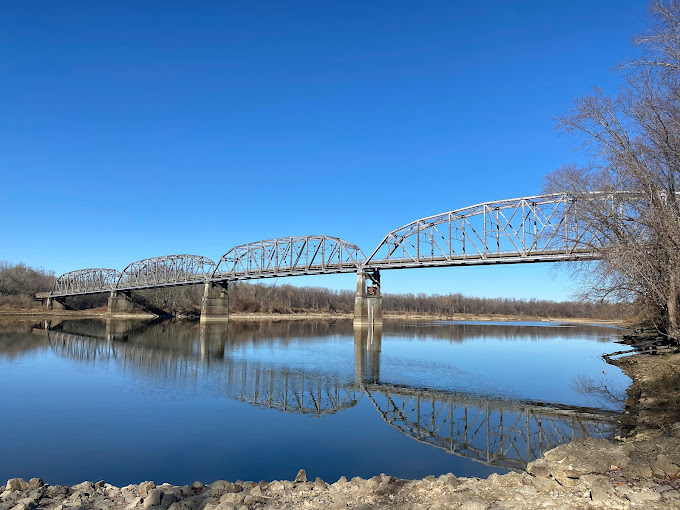
After following the Harmony Way Bridge closing for years now, WROY/WRUL News has continued to keep up with the goings on of a small, but dedicated group of individuals “efforting” the span’s re-opening. With that, our reporters have been faced with input from the community over the years, prompting us to ask those actively trying to help grant new life to the bridge, “What would you tell those who say the effort to reopen the bridge is a fool’s errand?”
The current Illinois New Harmony Bridge Authority is made up of Spud Egbert (Chair), Sara Brown (Vice Chair), Linda Henning (Secretary/Treasurer), Ellen Schanzle-Haskins, and Clint Spencer. Below is Mrs. Henning’s response:
The short answer is: It’s not foolish…if no one tries, nothing will happen. If nothing happens, at least we tried.
The long answer is: America’s interstate highway system, first conceived in the 1930s and implemented in 1956, spawned the building of a network of fast and convenient transportation corridors by circumventing rural routes across the United States. Ironically, the Harmony Way Bridge was opened in 1930 to connect two rural roads, Indiana State Road 66 in Posey County, Indiana and Illinois Route 14 in White County, Illinois, over the Wabash River.
The conundrum, the construction of the Harmony Way Bridge and the beginning of the interstate highway system, is that while the Bridge was being built to connect these counties, an interstate highway (I-64) was being constructed that would eventually disconnect these counties.
Interstate 64, a 953.74 mile (1,534.90 km) route created a transportation freeway from Missouri to Virginia, speeding vehicular traffic past a once thriving, albeit more leisurely, section of southern Illinois and southern Indiana.
However, progress sometimes comes with a downside. Over the years, as I-64 traffic bypassed these downstate sections of Illinois and Indiana, growth declined and tax revenue decreased for Crossville and Carmi, Illinois and New Harmony, Indiana as well as for communities beyond these adjacent towns.
Decreased Traffic, Reduced Tolls, No Funds for Bridge Repairs
As I-64 traffic sidestepped the Bridge’s connection with Illinois Route 14 and Indiana State Road 66 (which is Church Street in New Harmony, Indiana) the declining toll revenue was not sufficient enough to safely maintain the Bridge.
Failed Infrastructure Policy
An additional funding obstacle was the lack of access to government funds. The Bridge was supervised by the White County Bridge Commission, a private entity mandated by the U.S. Congress in 1941, and the Commission was not eligible to apply for government grants to supplement the decreasing toll revenue. Essentially, this was a failed infrastructure policy: mandating a private commission to maintain the bridge without access to government support.
Ironically, as the entirety of I-64 was completed in 2009, the Harmony Way Bridge closed just three years later in 2012 due to a lack of funds for repairs which strangled economic opportunities by decreasing tourism, job, health care, recreational, and small business access on both sides of the Wabash River.
Fool’s Errand Begins in 2019?
Fast forward to February 2019 when President Trump signed the Harmony Way Bridge Act abolishing the White County Bridge Commission and allowing the formation of the Illinois New Harmony River Bridge Authority and the Indiana Wabash River Bridge Authority.
The Illinois New Harmony Bridge Authority Act states:
(45 ILCS 185/5-5) Sec. 5-5. Findings; intent. The General Assembly finds that the New Harmony Bridge, which crosses the Wabash River south of Interstate 64 and has an entrance span in Illinois and Indiana, is in need of rehabilitation. The White County Bridge Commission, a private entity created by Congress in 1941, lacks the resources necessary to rehabilitate and maintain the bridge. The New Harmony Bridge provides an important link between this State [Illinois] and Indiana. The rehabilitation and continued use of the New Harmony Bridge is essential to preserve and improve the public welfare and prosperity of the people of this State. It is in the best interests of the public welfare and public safety that this State and the State of Indiana work together to repair and maintain this historical bridge. The intent of this Act is to ensure that the New Harmony Bridge is rehabilitated and maintained so that it can meet the needs of motorists for years to come. (Source: P.A. 100-981, eff. 8-19-18.)
However, history has almost repeated itself because the Act did not include supplemental funding again! Another infrastructure policy failure.
Since 2019, both the Illinois and Indiana Authorities have been working together to apply for federal and state funding to plan and refurbish the Bridge. Indiana generously supplied seed money to conduct a preliminary engineering study to determine the scope of the repairs. After meticulous engineering and underwater studies were conducted, it was determined that the Bridge could be rehabilitated. The imminent task is to fine-tune the vision and the plan, develop a detailed construction estimate, and apply for funding.
The Harmony Way Bridge was identified as a top priority among the thousands of rural bridges in the United States worthy of repair in President Biden’s “American Jobs Plan” proposed on March 31, 2021.*
Members of both Authorities have spent numerous volunteer hours to write and submit grants for federal and state funds with assistance from the Illinois Department of Transportation (IDOT). Bi-partisan letters of support have also been submitted along with the Rebuilding American Infrastructure with Sustainability and Equity (RAISE) grant application offered through the U.S. Department of Transportation.
Federal and state grants are highly competitive and it may take several applications (we have applied for at least five grants) to be awarded the funds to complete the rehabilitation of the Harmony Way Bridge as it was intended in 1930; a two-lane structure with a 15-ton load limit – with perhaps the addition of a bike/hike path. The recreational and environmentally responsible business opportunities that the reopening of the Bridge could bring to this area are limited only by the imagination.
A fool’s errand? It would be foolish not to try to reopen the historic Harmony Way Bridge.
* Rojas, Rick. “Seven Infrastructure Problems in Urgent Need of Fixing » New York Times, April 2, 2021”. Retrieved April 2, 2021.
https://www.pbs.org/video/brief-but-spectacular-take-on-improving-health-near-highways-1674174075/












